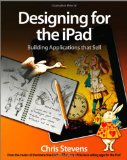Compelling applications on mobile devices, spearheaded by the Apple iPhone, iPod Touch, and iPad, are introducing a new generation of people to computing technology as well as giving everyone access to innovative ways of interacting with applications, primarily with touch screens, GPS, and accelerometers. Especially due to the much smaller screen real estate and touch interface, designing effective applications for these devices can be a difficult task. As creator of the interactive book Alice for the iPad, one of the best-selling applications for the iPad, Chris Stevens provides an introduction and primer to these design issues and considerations in his book Designing for the iPad: Building Applications that Sell.
In the book Stevens discusses 1.) how the iPad is a much different platform than the traditional personal computer, 2.) how to think about and plan your iPad application idea, 3.) how to design for touchscreen interfaces, and 4.) how to market your application.
Part 1 is interesting perhaps for those who are new to mobile devices with touchscreen interfaces, like the iPhone and iPad. This part seems slightly excessive because I’ve found most people adapt quite readily to mobile devices. In fact, in my experience most people who’ve never seen the Kindle try to turn the pages using a finger-swipe. So I think physically interacting with the device is a behavior most people can relate to and so less text related to this issue would be a benefit.
Part 2 is useful for developers new to software development–working with clients, developing prototypes, iterative designs, etc.
Part 3 contains useful tips on designing touch application user interfaces (because, for example, the hand may obscure important screen information when touching a particular button) and designing book and magazine applications. This section also includes code examples from the author’s own Alice for the iPad application.
Part 4 contains tips on marketing your application, such as tips on choosing a good application name, the importance of a good YouTube video, and adjusting application price based on sales data.
While this book contains useful design considerations for iPad applications, I feel that the market for this book is rather narrow. Developers–those who know how to code–will likely be frustrated in that no downloadable source code is available (as far as I can tell). Source code snippets in the book text are given for various scenes in the author’s Alice application, but readers are not able to download project code and follow along with the discussion in those sections of the book. Moreover, since the reader cannot download the code, some 18 Alice book scenes worth, this large number of scenes presented as code in a book with no download option seems a bit excessive. Perhaps a better approach, if no downloadable code is allowed, especially since not all readers will be familiar with the Alice iPad application, would have been to pick just a few exemplary scenes and provide more detailed analysis along with the code, so the reader could get a better understanding of how the third-party Chipmunk Physics library can be used to create interactive, physics-based applications. As is, this book will not help you learn to program iPad applications.
I think experienced designers may also be disappointed in the book. While the book is good to highlight the importance of typography and issues related to the small real estate screens of mobile devices, only warnings are given–no industry best-practices are presented that experienced designers could incorporate into their designs.
Finally, this book is plagued with many pages of filler screen shots of third-party applications and designs that have no comment or analysis in the corresponding text. So in this respect, certain parts of this book are like a coffee table book of design, since the pictures are visually appealing but lack a certain rigor of analysis, while other parts include actual code, but provide no way to download the code to make it implementable.
So, this book is a visually appealing discussion of the importance of good design in making good iPad applications, along with code snippets of how the author used the Chipmunk Physics library to create a notable digital popup-book iPad application. If that’s what you are looking for, then this book is just what you are looking for.
Available on Amazon: Designing for the iPad: Building Applications that Sell
